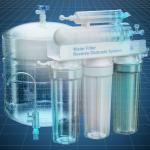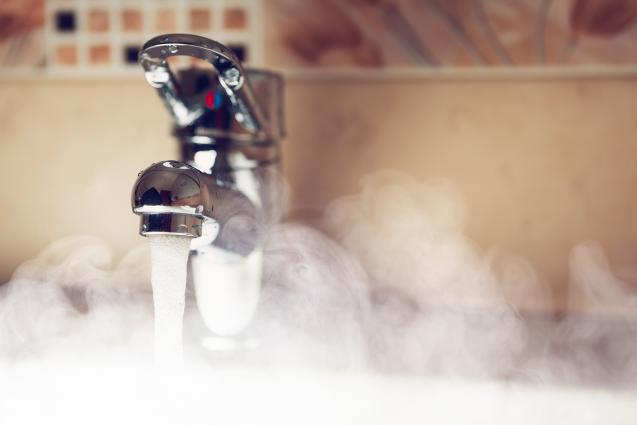
What Is A Reverse Osmosis Water Filter System?
By Fluid Plumbing|March 24, 2023
When you need a steady supply of high-quality filtered water, you can rely on reverse osmosis (RO) systems. Here, we'll explain everything there is to know about RO so you can have great tasting water whenever you want it.
How Does A Reverse Osmosis Water Filter Work?
As its name suggests, RO reverses osmosis, a natural process that happens in all organisms with cells, including plants, animals, and even people. During regular osmosis, a solution with less water flows through a semipermeable membrane and into a solution with more water. This balances the amount of water in both solutions.
In contrast to osmosis, which is a passive process, reverse osmosis needs a force or pressure from the outside to happen. A highly concentrated solute solution, like saltwater, is put under pressure so it can move through a membrane and become a less concentrated solution. The membrane lets water pass through, but it stops bigger molecules, like contaminants, from getting through. The process of reverse osmosis puts more of the solute on one side and just the solvent, or filtered water, on the other.
What Are The Benefits Of Reverse Osmosis?
There are a number of reasons why you might want a reverse osmosis system installed in your home to give you better drinking water. As you will have seen from the above explanation of what RO can do, you’ll understand how it can remove harmful contaminants from the water that comes out of your tap – it filters them out.
The fact that you’re not drinking these pollutants that would otherwise be in your drinking water without an RO system in place is a major benefit to having one, but on top of this, the system will reduce the amount of sodium in your water and reduce any bad tastes and odours, meaning you can enjoy your water much more and not have to add any flavourings or resort to soda as an alternative.
Plus, these systems are easy to install and maintain, so you’re not giving yourself a lot of additional work to get this great water in your home.
Reverse Osmosis vs Filtered Water
Using a water filter, whether that be in a jug, a fridge system, or perhaps something connected to your kitchen tap, will be useful when it comes to getting better water. However, although it’s better than drinking water straight from the tap, the water you’ll get from using an RO system is actually of much better quality, no matter what kind of filter you might be using.
This is mainly due to the number of contaminants an RO system can remove. Due to its internal membranes, it lets far fewer pollutants through to the water than standard filters will do. So if you want the best water possible to drink at home, an RO system has to be your ultimate option.
Things To Consider When Buying A Reverse Osmosis System
Just as there are many different types of water filters, there are many different types of RO systems, and some will suit you better than others. In order to choose the right one for your needs, you’ll have to consider a few points.
The first is your water source; where does the water come into your home? This will affect where the RO system is installed, and it might mean you need to choose a smaller unit to ensure it fits comfortably in the space. You’ll also need to think about the water demand in your home. If you drink a lot of water, you’ll need a larger tank, otherwise you’ll run out. Water pressure will play a big part in the installation, but if it’s high, you can install a pressure reducing valve to reduce the risk of damage.
Your budget is another consideration. If you install a whole house RO system, it’s going to cost a lot more than having a simple unit installed under your kitchen sink. What can you sensibly afford?
If you’re interested in an RO system for your home, the best thing to do is contact a reputable plumber about your options..
How Does A Reverse Osmosis Water Filter Work?
As its name suggests, RO reverses osmosis, a natural process that happens in all organisms with cells, including plants, animals, and even people. During regular osmosis, a solution with less water flows through a semipermeable membrane and into a solution with more water. This balances the amount of water in both solutions.
In contrast to osmosis, which is a passive process, reverse osmosis needs a force or pressure from the outside to happen. A highly concentrated solute solution, like saltwater, is put under pressure so it can move through a membrane and become a less concentrated solution. The membrane lets water pass through, but it stops bigger molecules, like contaminants, from getting through. The process of reverse osmosis puts more of the solute on one side and just the solvent, or filtered water, on the other.
What Are The Benefits Of Reverse Osmosis?
There are a number of reasons why you might want a reverse osmosis system installed in your home to give you better drinking water. As you will have seen from the above explanation of what RO can do, you’ll understand how it can remove harmful contaminants from the water that comes out of your tap – it filters them out.
The fact that you’re not drinking these pollutants that would otherwise be in your drinking water without an RO system in place is a major benefit to having one, but on top of this, the system will reduce the amount of sodium in your water and reduce any bad tastes and odours, meaning you can enjoy your water much more and not have to add any flavourings or resort to soda as an alternative.
Plus, these systems are easy to install and maintain, so you’re not giving yourself a lot of additional work to get this great water in your home.
Reverse Osmosis vs Filtered Water
Using a water filter, whether that be in a jug, a fridge system, or perhaps something connected to your kitchen tap, will be useful when it comes to getting better water. However, although it’s better than drinking water straight from the tap, the water you’ll get from using an RO system is actually of much better quality, no matter what kind of filter you might be using.
This is mainly due to the number of contaminants an RO system can remove. Due to its internal membranes, it lets far fewer pollutants through to the water than standard filters will do. So if you want the best water possible to drink at home, an RO system has to be your ultimate option.
Things To Consider When Buying A Reverse Osmosis System
Just as there are many different types of water filters, there are many different types of RO systems, and some will suit you better than others. In order to choose the right one for your needs, you’ll have to consider a few points.
The first is your water source; where does the water come into your home? This will affect where the RO system is installed, and it might mean you need to choose a smaller unit to ensure it fits comfortably in the space. You’ll also need to think about the water demand in your home. If you drink a lot of water, you’ll need a larger tank, otherwise you’ll run out. Water pressure will play a big part in the installation, but if it’s high, you can install a pressure reducing valve to reduce the risk of damage.
Your budget is another consideration. If you install a whole house RO system, it’s going to cost a lot more than having a simple unit installed under your kitchen sink. What can you sensibly afford?
If you’re interested in an RO system for your home, the best thing to do is contact a reputable plumber about your options..



